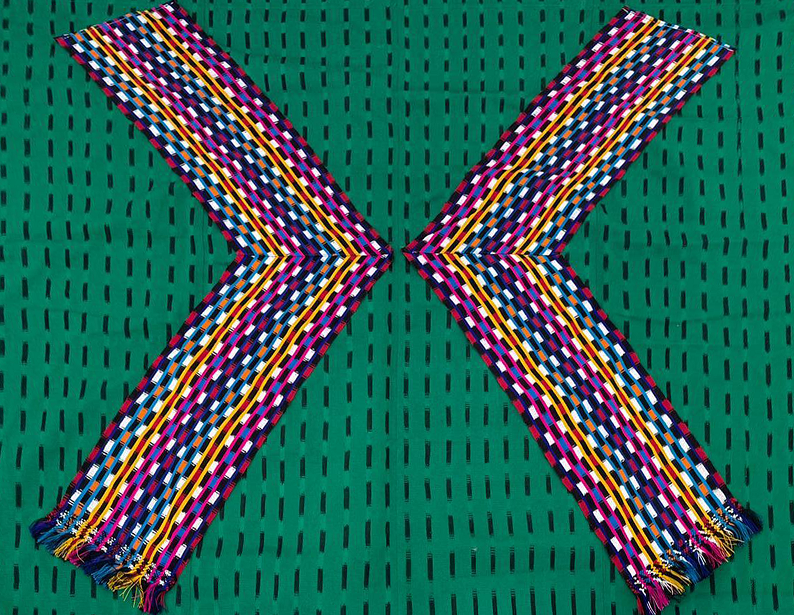
ANTONIA PICHILLA: IN FRONT OF THE LAKE
Antonio Pichillá’s first solo exhibition in Europe at Elizabeth Xi Bauer Gallery closely follows Inherited Threads, at Tate Modern, a new collection display of works by North and Latin American artists that were recently acquired by the institution, as well as Antonio Pichillá Quiacaín: Tejiendo El Paisaje, a video installation at the Museum of Contemporary Art Santa Barbara.

Antonio Pichillá, Contemporary archaeology, 2014-2021. Stones and textiles. Variable measures (consists of a set of 6 pieces of stones). Courtesy the Artist and Elizabeth Xi Bauer Gallery, London. Image above: Antonio Pichillá, Wind, 2022. Handcrafted textile, mercerised threads and sedalina,, 115 x 121 cm. Courtesy the Artist and Elizabeth Xi Bauer Gallery, London.
For the exhibition, Pichillá will experiment with ways of hanging and displaying his works, including: hanging them from the ceiling; video installation; as well as utilising found objects from nature and alongside those that are man-made.
Antonio Pichillá focuses on the ever-developing connections between western contemporary art and the vernacular tradition of craft. Using natural materials Pichillá draws from Mayan epistemology to: “Restlessly look for a bond that integrate(s) with the environment as something inexact, un-codified. I struggle to give form to transitory states”.

Image: The artist’s studio.
Examining the ancient culture of his native Tz’utujil heritage and the postcolonial notion of a homogenous national identity, Pichillá’s works are an act of resistance to otherness and binary constructions of identity. Instead, his work celebrates the heterogeneity of everyday contemporary Tz’utujil life. From his studio at Lake Atitlán the artist's practice is driven by anthropological research into Guatemala’s urban and rural regions. Pichillá is interested in the relationship between found natural objects, such as rocks and branches and his textile works, as well as man-made objects.

Image: detail of Viento, Antonio Pichillá.
Two works which celebrate contemporary life juxtaposed with traditions of the Tz’utujil, are La Piedra De Sol (The Sun Stone) and Espantapajaro (Scarecrow). La Piedra De Sol (The Sun Stone) is inspired by a day in the Mayan calendar, B’atz (Knot) day, which celebrates beginning and ending, tying and untying, winding and unwinding, much like existence itself. It is also a healing mechanism too, like a necklace used by spirit guides today. Espantapajaro (Scarecrow) is inspired by scarecrows that the artist has seen, the handmade form that helps protect growing plants from birds. For the artist, it is an important part within the agricultural life cycle, especially early on when the crop is vulnerable at the beginning of February when the first rains fall. The work is made from found threads, textiles and pieces of wood creating a protective yet strange, menacing shape. The artist is interested in the relationship between bodies, memory, fabric, and identity.
In Pichillá’s Grandfather series (2014 – 2020) he reclaims textile art and examines his relationship with his mother, a weaver.
The artist explains, ‘’In San Pedro la Laguna, Sololá, a Maya Tz’utujil town, men’s trousers are made from white fabric with a pattern consisting of black vertical marks. Inspired by this pattern design, in these works I have incorporated fabrics dyed in red, black and yellow. Such colorful designs are uncommon, for those both those wearing and weaving them alike. My inclusion of these colours is a gesture to the four colours of corn. I start with the main pattern and then alter it and assemble it over the stretched canvas. From the perspective of western aesthetics, this technique might be perceived as resembling minimalist painting from the mid-twentieth century. Nevertheless, these pieces could be interpreted as a type of “intercultural abstraction” employing codes that arise from within their context of production.’’

Image: Antonio Pichillá, Kukulkan, 2022. Handcrafted textile, mercerised threads and sedalina, 120 x 80 cm. Courtesy the Artist and Elizabeth Xi Bauer Gallery, London.
Pichillá’s Grandmother series (2016 – 2020) connects him with generations of Guatemala’s Maya female weavers.
‘’Guatemala has an enormous cultural richness when it comes to textiles, and it is usually women who design and weave them. Their skills are transferred from generation to generation. The materials and tools used in the art of weaving fulfill fundamental functions. For example, the warping frame is essential for designing textiles. It consists of a flat wooden surface fitted with pegs. In the case of a backstrap loom, counting the threads, tying, and measuring them, is achieved by using one's fingers, thus conjoining the tool with the body,’’ Pichillá explains.
‘’Through these actions, I create works related to the warping frame. Over the surface of a canvas, I placed threads reaching different directions, joining various strands and fibres of maguey, and then wrapped them over a stretcher. For the textile pieces, I made braids using thread fringes, resembling a grandmother’s hairdo.’’

Image: Antonio Pichillá, Pathway, 2022. Handcrafted textile, mercerised threads and sedalina, 120 x 80 cm. Courtesy the Artist and Elizabeth Xi Bauer Gallery, London.
These works act as Pichillá’s tribute to Maya women as he explains, ‘’Currently, it is indigenous women who are resisting, protecting and embracing the use of traditional clothing in Guatemala’s Maya communities.’’
As part of this exhibition at Elizabeth Xi Bauer, Pichillá will launch a publication which explores his artistic practice to date as well as seminal works from his career. The publication includes an introduction by curator Alexia Tala; writings from curator Cecilia Fajardo Hill; anthropologist Maria Jacinta Xon; as well as an interview with the artist conducted by Pablo José Ramírez, the Adjunct Curator of First Nations and Indigenous Art at Tate Modern.
Antonio Pichillá: In Front of the Lake will be on show at Elizabeth Xi Bauer until 11 November 2023. Find out more:
elizabethxibauer.com

Antonio Pichillá, Contemporary archaeology, 2014-2021. Stones and textiles. Variable measures (consists of a set of 6 pieces of stones). Courtesy the Artist and Elizabeth Xi Bauer Gallery, London. Image above: Antonio Pichillá, Wind, 2022. Handcrafted textile, mercerised threads and sedalina,, 115 x 121 cm. Courtesy the Artist and Elizabeth Xi Bauer Gallery, London.
For the exhibition, Pichillá will experiment with ways of hanging and displaying his works, including: hanging them from the ceiling; video installation; as well as utilising found objects from nature and alongside those that are man-made.
Antonio Pichillá focuses on the ever-developing connections between western contemporary art and the vernacular tradition of craft. Using natural materials Pichillá draws from Mayan epistemology to: “Restlessly look for a bond that integrate(s) with the environment as something inexact, un-codified. I struggle to give form to transitory states”.

Image: The artist’s studio.
Examining the ancient culture of his native Tz’utujil heritage and the postcolonial notion of a homogenous national identity, Pichillá’s works are an act of resistance to otherness and binary constructions of identity. Instead, his work celebrates the heterogeneity of everyday contemporary Tz’utujil life. From his studio at Lake Atitlán the artist's practice is driven by anthropological research into Guatemala’s urban and rural regions. Pichillá is interested in the relationship between found natural objects, such as rocks and branches and his textile works, as well as man-made objects.

Image: detail of Viento, Antonio Pichillá.
Two works which celebrate contemporary life juxtaposed with traditions of the Tz’utujil, are La Piedra De Sol (The Sun Stone) and Espantapajaro (Scarecrow). La Piedra De Sol (The Sun Stone) is inspired by a day in the Mayan calendar, B’atz (Knot) day, which celebrates beginning and ending, tying and untying, winding and unwinding, much like existence itself. It is also a healing mechanism too, like a necklace used by spirit guides today. Espantapajaro (Scarecrow) is inspired by scarecrows that the artist has seen, the handmade form that helps protect growing plants from birds. For the artist, it is an important part within the agricultural life cycle, especially early on when the crop is vulnerable at the beginning of February when the first rains fall. The work is made from found threads, textiles and pieces of wood creating a protective yet strange, menacing shape. The artist is interested in the relationship between bodies, memory, fabric, and identity.
In Pichillá’s Grandfather series (2014 – 2020) he reclaims textile art and examines his relationship with his mother, a weaver.
The artist explains, ‘’In San Pedro la Laguna, Sololá, a Maya Tz’utujil town, men’s trousers are made from white fabric with a pattern consisting of black vertical marks. Inspired by this pattern design, in these works I have incorporated fabrics dyed in red, black and yellow. Such colorful designs are uncommon, for those both those wearing and weaving them alike. My inclusion of these colours is a gesture to the four colours of corn. I start with the main pattern and then alter it and assemble it over the stretched canvas. From the perspective of western aesthetics, this technique might be perceived as resembling minimalist painting from the mid-twentieth century. Nevertheless, these pieces could be interpreted as a type of “intercultural abstraction” employing codes that arise from within their context of production.’’

Image: Antonio Pichillá, Kukulkan, 2022. Handcrafted textile, mercerised threads and sedalina, 120 x 80 cm. Courtesy the Artist and Elizabeth Xi Bauer Gallery, London.
Pichillá’s Grandmother series (2016 – 2020) connects him with generations of Guatemala’s Maya female weavers.
‘’Guatemala has an enormous cultural richness when it comes to textiles, and it is usually women who design and weave them. Their skills are transferred from generation to generation. The materials and tools used in the art of weaving fulfill fundamental functions. For example, the warping frame is essential for designing textiles. It consists of a flat wooden surface fitted with pegs. In the case of a backstrap loom, counting the threads, tying, and measuring them, is achieved by using one's fingers, thus conjoining the tool with the body,’’ Pichillá explains.
‘’Through these actions, I create works related to the warping frame. Over the surface of a canvas, I placed threads reaching different directions, joining various strands and fibres of maguey, and then wrapped them over a stretcher. For the textile pieces, I made braids using thread fringes, resembling a grandmother’s hairdo.’’

Image: Antonio Pichillá, Pathway, 2022. Handcrafted textile, mercerised threads and sedalina, 120 x 80 cm. Courtesy the Artist and Elizabeth Xi Bauer Gallery, London.
These works act as Pichillá’s tribute to Maya women as he explains, ‘’Currently, it is indigenous women who are resisting, protecting and embracing the use of traditional clothing in Guatemala’s Maya communities.’’
As part of this exhibition at Elizabeth Xi Bauer, Pichillá will launch a publication which explores his artistic practice to date as well as seminal works from his career. The publication includes an introduction by curator Alexia Tala; writings from curator Cecilia Fajardo Hill; anthropologist Maria Jacinta Xon; as well as an interview with the artist conducted by Pablo José Ramírez, the Adjunct Curator of First Nations and Indigenous Art at Tate Modern.
Antonio Pichillá: In Front of the Lake will be on show at Elizabeth Xi Bauer until 11 November 2023. Find out more:
elizabethxibauer.com
